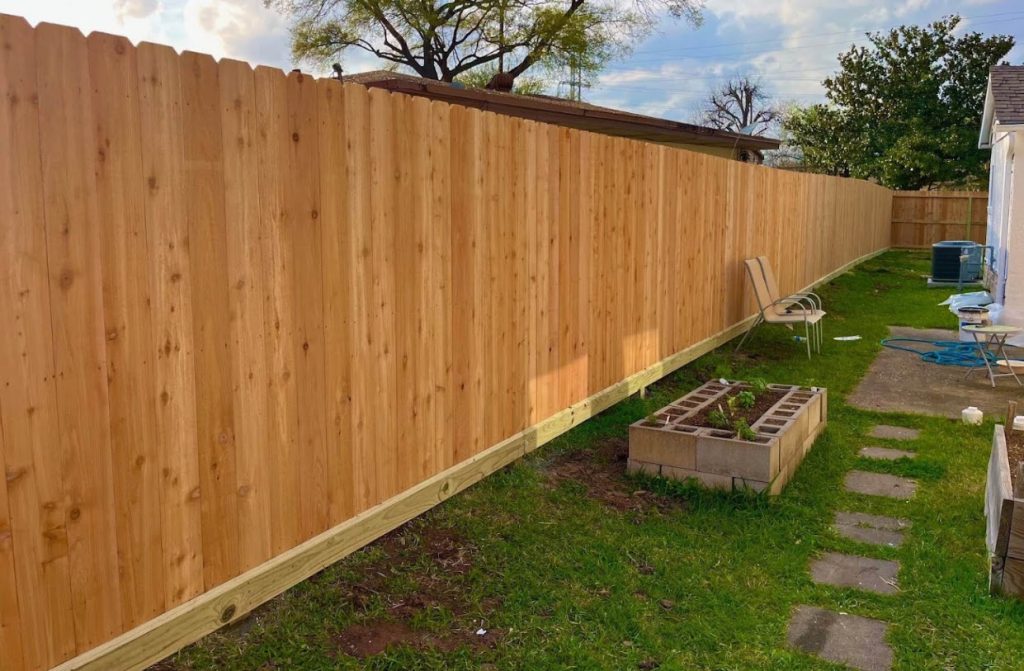Top 7 Tips for Fast Fence Repair in Houston
We’ve seen our share of fence damage in Houston, where harsh weather and soil conditions can wreak havoc on even the sturdiest barriers. Whether you’re dealing with a loose post, rotted boards, or rusted metal components, tackling repairs quickly prevents further deterioration and keeps your property secure. Let’s explore the proven techniques we’ve developed through years of experience – from proper damage assessment to weatherproofing strategies that’ll help your fence stand strong against Houston’s challenging climate. The fence repair in Houston process isn’t complicated once you understand the essential steps and have the right tools at hand.

Key Points on Fence Repair in Hosuton
- Keep concrete mix and repair materials ready during Houston’s hurricane season for emergency fence repairs within 24 hours.
- Use quick-setting concrete specifically designed for hot climates to stabilize fence posts in Houston’s humid conditions.
- Apply weather-resistant sealants and coatings that withstand intense UV exposure and frequent rain common in Southeast Texas.
- Install proper drainage solutions around fence posts to prevent soil erosion during Houston’s heavy rainfall events.
- Choose rust-resistant hardware and metal components specifically rated for coastal environments to combat Houston’s salt-air exposure.
Assess and Document Fence Damage
Before beginning any fence repair in Houston, a thorough assessment and documentation of the damage will guarantee accurate cost estimates and proper repair planning. We’ll want to inspect every section systematically, checking for rotted wood, rusted metal, loose posts, and compromised foundations.
Let’s photograph all damaged areas from multiple angles and measure the affected sections precisely. We’ll document specific issues like termite damage, weather wear, or impact damage from fallen branches. We should note the fence’s materials, age, and any previous repairs that might affect our current work.
In Houston’s climate, we’ll pay special attention to water damage and soil erosion around posts, as these are common issues that can compromise the entire fence structure. This detailed assessment helps us choose the right materials and repair methods.
According to industry data, rotting fence posts account for 40% of all fence repairs, making this a critical area to examine during the assessment phase.
Gather Essential Repair Tools
After completing our damage assessment, we’ll need a thorough set of tools to execute repairs efficiently. Let’s gather our essential equipment before starting any fence repair in Houston’s challenging climate.
Power tools: Cordless drill with bits, circular saw, post hole digger, and level for precise alignment Hand tools: Hammer, measuring tape, carpenter’s pencil, pliers, and wire cutters for detailed work Fastening materials: Screws, nails, brackets, concrete mix, and post anchors appropriate for your fence type Safety equipment: Work gloves, safety glasses, dust mask, and sturdy boots to protect ourselves
We’ll want to organize these tools in a portable container or toolbox for easy access during repairs. Having everything ready will minimize trips to the hardware store and keep our repair process moving smoothly.
Professional installation ensures superior craftsmanship and precision for complex fence repairs.
Stabilize Loose Fence Posts
When we encounter loose fence posts in Houston’s soil conditions, we’ll need to establish a solid concrete support base to prevent future shifting and instability.
We can mix quick-setting concrete and pour it around the post base, ensuring it extends at least 2 feet below ground level for maximum stability. For additional reinforcement, we’ll install post hole anchors that grip into the surrounding soil and concrete, creating a three-point stabilization system that resists both lateral movement and uplift forces.
It’s essential to ensure post depth requirements are met by securing at least one-third of the total post length underground.
Add Concrete Support Base
Loose fence posts can destabilize an entire fence line, making swift repairs essential for maintaining structural integrity. When we’re adding a concrete support base to reinforce posts in Houston’s diverse soil conditions, we’ll need to work methodically to guarantee lasting results.
Let’s follow these critical steps for a proper concrete support installation:
- Dig around the post to create a hole at least 24 inches deep and three times the post’s width
- Mix quick-setting concrete according to manufacturer’s specifications for our humid climate
- Position the post precisely with a level while pouring the concrete mix
- Slope the concrete slightly away from the post to prevent water pooling
We’ll want to let the concrete cure for at least 24 hours before reattaching any fence panels or gates.
Use Post Hole Anchors
For quick stabilization of wobbly fence posts, post hole anchors offer a reliable alternative to complete concrete replacement. We’ll want to dig small holes around the affected post, then slide the anchors into position against the post’s base. These anchors, typically made of galvanized steel, grip into the surrounding soil to provide immediate support.
We recommend using at least four anchors per post, spacing them evenly around the base. Drive each anchor into the ground at a 15-degree angle away from the post, ensuring they’re below the soil line. Once installed, we can backfill the holes with compacted soil. This method works especially well in Houston’s clay-heavy soil and can withstand our region’s frequent rain and humidity, providing a fast solution that’ll keep your fence stable for years.
Fix Weather-Damaged Wood Panels
We’ll tackle those weather-damaged wood panels by first removing and replacing any boards showing signs of rot or severe water damage.
Once we’ve installed the new boards, we’ll sand down any rough spots and apply a high-quality weather sealant to protect against future moisture intrusion.
Let’s guarantee proper drainage around the fence line and consider adding a water-repellent finish to extend the life of your wooden fence panels.
Regular cleaning and inspection helps catch moisture damage signs early before they develop into serious structural issues.
Replace Rotted Boards First
Before making any other fence repair in Houston, identifying and replacing rotted wooden boards should be your top priority. We’ll help you tackle this critical first step to guarantee your fence’s structural integrity and longevity.
Let’s examine the proper way to replace rotted boards effectively.
- Remove the damaged board by carefully prying it away from the fence posts using a pry bar, making sure not to damage surrounding materials
- Clean the exposed area thoroughly, removing any remaining rot, old nails, or debris
- Cut your replacement board to match the exact dimensions of the removed piece, treating it with weather-resistant sealant before installation
- Secure the new board using galvanized nails or screws, verifying it’s properly aligned with adjacent boards
Remember to inspect the posts and surrounding boards for signs of spreading rot while you’re making the replacement.
Seal Against Future Damage
The key to protecting your wooden fence from future weather damage lies in proper sealing and maintenance. Let’s apply a high-quality sealant once we’ve cleaned and repaired any damaged boards. We recommend using a water-repellent sealer with UV protection for Houston’s intense sun and frequent rain.
| Sealing Step | Time Required | Tools Needed |
|---|---|---|
| Clean Surface | 2-3 hours | Pressure washer |
| Sand Rough Areas | 1-2 hours | Electric sander |
| Apply First Coat | 2-4 hours | Paint sprayer |
| Apply Second Coat | 2-4 hours | Paint roller |
We’ll want to seal our fence every 2-3 years, depending on weather exposure. For best results, we should apply sealant during dry weather when temperatures range between 50-80°F. This timing allows proper curing and maximizes protection against Houston’s humidity and rainfall.
Repair Metal Fence Components
Maintaining metal fence components requires specific repair techniques and tools to address common issues like rust, bent sections, and damaged hardware. We’ll help you tackle these repairs effectively to restore your fence’s strength and appearance.
Remove rust spots by wire brushing the affected areas, applying a rust converter, and finishing with rust-resistant paint that matches your fence color.
Straighten bent metal sections using a rubber mallet and leverage bar, working gradually to avoid metal fatigue or breaks.
Replace damaged hardware like hinges, latches, and brackets with corrosion-resistant alternatives designed for Houston’s humid climate.
Tighten loose posts by reinforcing the concrete foundation or installing metal braces for additional support.
Let’s work together to assess your metal fence damage and implement these proven repair solutions that’ll extend your fence’s lifespan.
Wrought iron fences require regular maintenance to prevent deterioration and maintain their elegant appearance.
Address Ground Erosion Issues
Ground erosion around fence posts represents a serious threat to your fence’s stability and longevity, particularly in Houston’s frequent heavy rains and flooding. We recommend installing concrete collars around post bases to prevent soil washout and maintain structural integrity. For immediate stabilization, we’ll pack crushed granite or limestone around affected posts.
To address more severe erosion, we’ll implement proper drainage solutions by grading the soil away from your fence line and installing French drains where needed. Let’s also add erosion-control ground cover or lay landscape fabric topped with river rock. In areas with persistent drainage issues, we’ll build small retaining walls to protect your fence’s foundation. These solutions won’t just protect your fence – they’ll preserve your property value and prevent costly future repairs. Regular gate inspections and maintenance are essential to ensure your fence system remains stable during Houston’s challenging weather conditions.
Weatherproof Your Repaired Fence
Every repaired fence in Houston needs proper weatherproofing to withstand our harsh climate conditions, from intense UV exposure to torrential rains. We’ll help you protect your investment with proven weatherproofing techniques that extend your fence’s lifespan.
Choosing materials like high-density polyethylene can significantly improve your fence’s resistance to weathering and UV damage.
We’ll want to reapply sealant every 2-3 years, depending on exposure levels, to maintain maximum protection against Houston’s challenging weather patterns.
- Apply a high-quality wood sealant or weatherproof stain that penetrates deep into the grain, creating a moisture-resistant barrier
- Install metal flashing along the top rails to prevent water from seeping into post joints
- Use rust-resistant hardware and galvanized nails or screws to prevent corrosion
- Add water-resistant caps to fence posts to prevent moisture accumulation and rot

Frequently Asked Questions About Fence Repair in Houston
How Long Should I Wait After Rain Before Starting Fence Repairs?
We recommend waiting 24-48 hours after rainfall before starting fence repair in Houston. If the soil’s still soggy when squeezed, let’s give it more time to dry completely.
What Permits Do I Need for Fence Repairs in Houston Neighborhoods?
We’ll need a residential repair permit from Houston’s Building Code Enforcement if we’re replacing over 50% of the fence. For minor repairs under 50%, we don’t require permits in most neighborhoods.
Can I Mix Different Fence Materials When Making Repairs?
We can mix fence materials for repairs, but we’ll want to match existing sections for visual consistency and structural integrity. Let’s choose materials that complement your current fence’s functionality and appearance.
How Often Should I Schedule Professional Fence Inspections?
We recommend scheduling professional fence inspections annually, though you’ll want more frequent checks if you’re in areas with harsh weather or have older fencing materials showing signs of wear.
What’s the Average Cost per Linear Foot for Emergency Fence Repairs in Houston?
We typically see emergency fence repairs ranging from $12-25 per linear foot, depending on material type, damage severity, and labor costs. We’ll evaluate your specific situation for accurate pricing.
Takeaway
We’ve covered essential steps for efficient fence repair in Houston with our challenging climate. By documenting damage, using proper tools, stabilizing posts, addressing wood and metal deterioration, and implementing erosion control measures, we’re ensuring lasting repairs. Let’s protect our investment by applying weather-resistant sealants and scheduling regular maintenance checks. Through these targeted solutions, we’ll maintain our fence’s structural integrity against Houston’s weather extremes.








